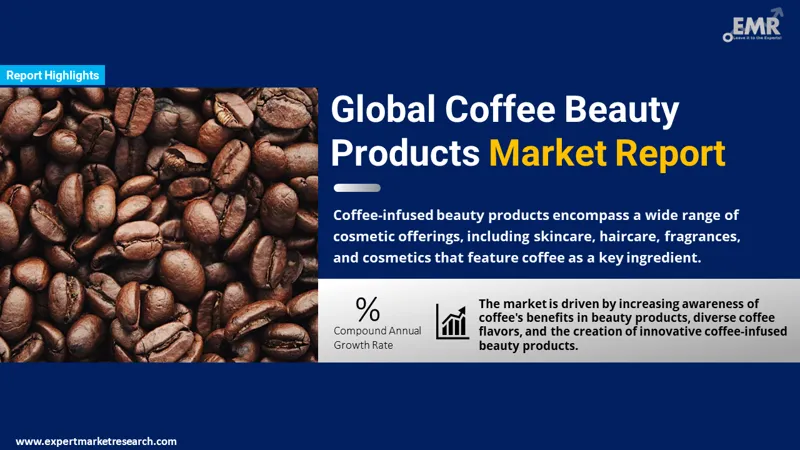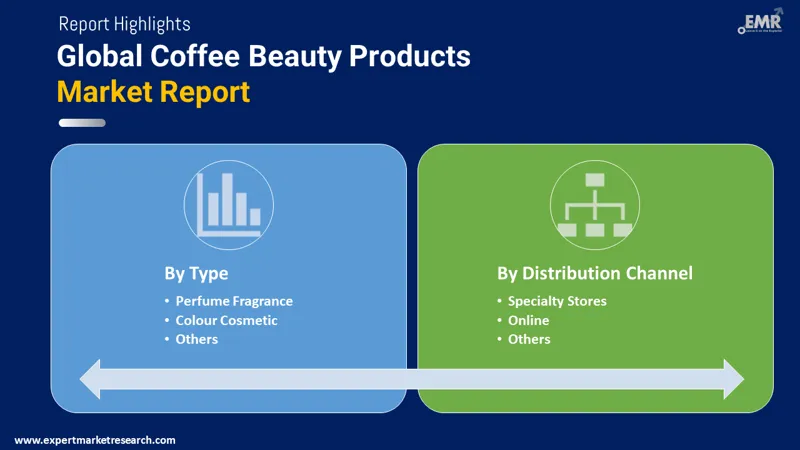
Consumer Insights
Uncover trends and behaviors shaping consumer choices today
Procurement Insights
Optimize your sourcing strategy with key market data
Industry Stats
Stay ahead with the latest trends and market analysis.
The global coffee beauty products market size reached a value of approximately USD 678.10 Million in 2025. The market is expected to grow at a CAGR of 5.40% between 2026 and 2035, reaching a value of USD 1147.36 Million by 2035.
Base Year
Historical Period
Forecast Period
Compound Annual Growth Rate
5.4%
Value in USD Million
2026-2035
*this image is indicative*
Coffee beauty products refer to beauty products such as skin care, hair care, fragrances, and cosmetics that contain coffee in some form. Adding coffee to beauty products is a common way to incorporate caffeine into the beauty items for skin benefits, hair benefits, and fragrances.

Read more about this report - REQUEST FREE SAMPLE COPY IN PDF
The EMR’s report titled “Coffee Beauty Products Market Report and Forecast 2026-2035” offers a detailed analysis of the market based on the following segments:
Market Breakup by Type
Market Breakup by Distribution Channel
Market Breakup by Region

Read more about this report - REQUEST FREE SAMPLE COPY IN PDF
The skin care segment, by type, accounts for a sizable share of the market for coffee beauty products owing to the rising concern of the people towards skin care especially among ageing adults. Among middle-aged and older users, the anti-ageing properties of caffeinated skin care products are driving the demand for the segment. Introduction of new skin care coffee products promising reduction of fatigue and oil along with enhanced cleaning is attracting more consumers towards the skin care coffee beauty products resulting in the overall growth of the market.
Europe held a significant share of the coffee beauty products global market owing to the widespread demand for beauty products and early acceptance of new trends and ingredients. The presence of major key players and the rising number of cosmetic manufacturing companies are further supporting the regional market growth. More users in Europe are adopting the use of organic and natural products as they are harmless to the skin unlike the chemical-based products. Rising disposable income has increased the spending of users on personal care products ultimately helping in the growth of the market.
The comprehensive EMR report provides an in-depth assessment of the market based on the Porter's five forces model along with giving a SWOT analysis. The report gives a detailed analysis of the following key players in the global coffee beauty products market, covering their competitive landscape and latest developments like mergers, acquisitions, investments and expansion plans.
Avon Products Inc. was founded in 1886 and is headquartered in London, United Kingdom. This cosmetics company manufactures and distributes skin care, personal care, and fragrance products to the consumers globally.
Estee Lauder Inc. is a multinational cosmetics company that was founded in 1946. It is headquartered in New York, United States and is known for providing makeup, hair care, fragrance, and skin care products.
The Procter and Gamble Company was established in 1837 and has its headquarters located in Ohio in the United States. This consumer goods company focuses on manufacturing liquid fabric softener, dish washing liquid, and personal and beauty products.
*Please note that this is only a partial list; the complete list of key players is available in the full report. Additionally, the list of key players can be customized to better suit your needs.*
Other market players include L’Oréal S.A., Unilever Plc, Bean Body, BioCare Ltd., The Body Shop, Java Skin Care, OGX Beauty, and Pep Technologies Pvt Ltd (mCaffeine), among others.




*While we strive to always give you current and accurate information, the numbers depicted on the website are indicative and may differ from the actual numbers in the main report. At Expert Market Research, we aim to bring you the latest insights and trends in the market. Using our analyses and forecasts, stakeholders can understand the market dynamics, navigate challenges, and capitalize on opportunities to make data-driven strategic decisions.*
Get in touch with us for a customized solution tailored to your unique requirements and save upto 35%!
The market for coffee beauty products reached a value of approximately USD 678.10 Million in 2025.
The market is expected to grow at a CAGR of 5.40% between 2026 and 2035.
The market is estimated to witness a healthy growth in the forecast period of 2026-2035 to reach a value of USD 1147.36 Million by 2035.
The key drivers in the market are growing female population, rising disposable income, and growing demand for organic products.
The key trends of the market are rising awareness regarding the advantages of coffee in beauty products, introduction of various coffee flavours, and development of new beauty products with coffee.
The various types of coffee beauty products in the market are skin care, hair care, perfume fragrance, and colour cosmetic, among others.
The different distribution channels for coffee beauty products are supermarkets and hypermarkets, convenience stores, specialty stores, and online, among others.
The coffee beauty products market key players, according to the report, are L’Oréal S.A., Avon Products, Inc., Estee Lauder Inc., The Procter and Gamble Company, Unilever Plc, Bean Body, BioCare Ltd., The Body Shop, Java Skin Care, OGX Beauty, and Pep Technologies Pvt Ltd (mCaffeine), among others.
Explore our key highlights of the report and gain a concise overview of key findings, trends, and actionable insights that will empower your strategic decisions.
| REPORT FEATURES | DETAILS |
| Base Year | 2025 |
| Historical Period | 2019-2025 |
| Forecast Period | 2026-2035 |
| Scope of the Report |
Historical and Forecast Trends, Industry Drivers and Constraints, Historical and Forecast Market Analysis by Segment:
|
| Breakup by Type |
|
| Breakup by Distribution Channel |
|
| Breakup by Region |
|
| Market Dynamics |
|
| Competitive Landscape |
|
| Companies Covered |
|
Datasheet
One User
USD 2,499
USD 2,249
tax inclusive*
Single User License
One User
USD 3,999
USD 3,599
tax inclusive*
Five User License
Five User
USD 4,999
USD 4,249
tax inclusive*
Corporate License
Unlimited Users
USD 5,999
USD 5,099
tax inclusive*
*Please note that the prices mentioned below are starting prices for each bundle type. Kindly contact our team for further details.*
Flash Bundle
Small Business Bundle
Growth Bundle
Enterprise Bundle
*Please note that the prices mentioned below are starting prices for each bundle type. Kindly contact our team for further details.*
Flash Bundle
Number of Reports: 3
20%
tax inclusive*
Small Business Bundle
Number of Reports: 5
25%
tax inclusive*
Growth Bundle
Number of Reports: 8
30%
tax inclusive*
Enterprise Bundle
Number of Reports: 10
35%
tax inclusive*
How To Order

Select License Type
Choose the right license for your needs and access rights.

Click on ‘Buy Now’
Add the report to your cart with one click and proceed to register.

Select Mode of Payment
Choose a payment option for a secure checkout. You will be redirected accordingly.
Gain insights to stay ahead and seize opportunities.

Get insights & trends for a competitive edge.

Track prices with detailed trend reports.

Analyse trade data for supply chain insights.

Leverage cost reports for smart savings

Enhance supply chain with partnerships.

Connect For More Information
Our expert team of analysts will offer full support and resolve any queries regarding the report, before and after the purchase.
Our expert team of analysts will offer full support and resolve any queries regarding the report, before and after the purchase.
We employ meticulous research methods, blending advanced analytics and expert insights to deliver accurate, actionable industry intelligence, staying ahead of competitors.
Our skilled analysts offer unparalleled competitive advantage with detailed insights on current and emerging markets, ensuring your strategic edge.
We offer an in-depth yet simplified presentation of industry insights and analysis to meet your specific requirements effectively.
Share